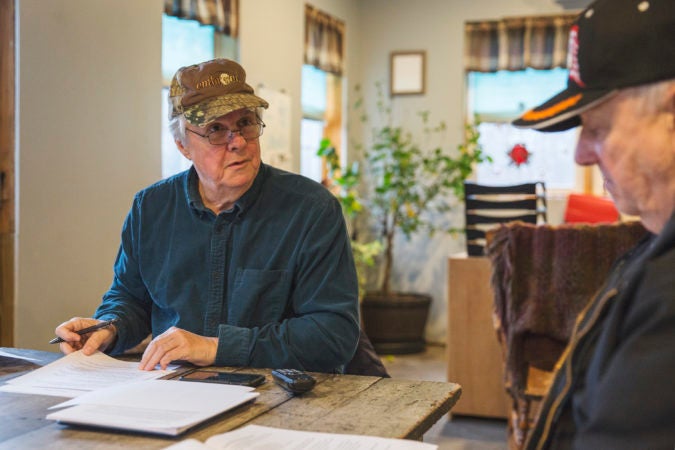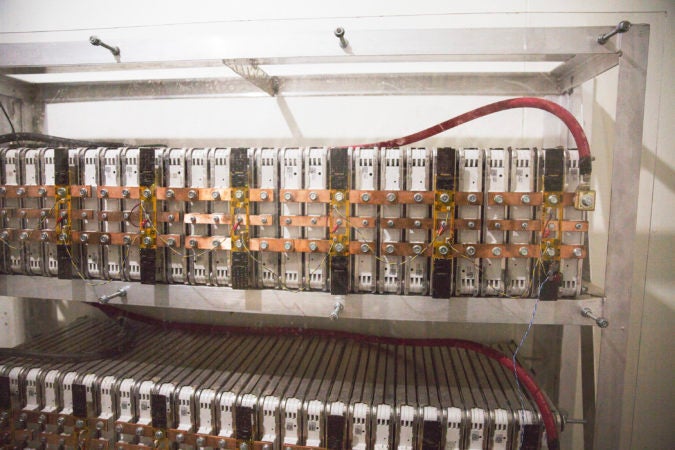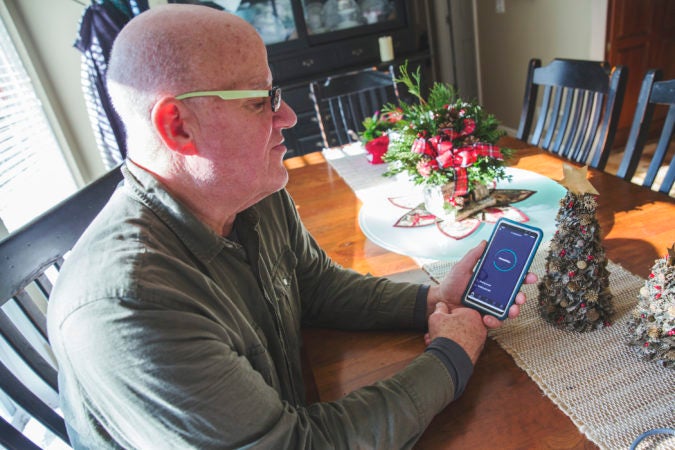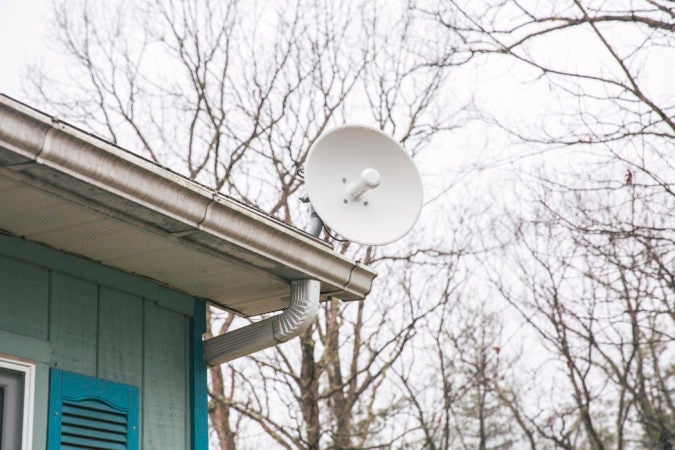This rag-tag group of DIYers has an answer for rural Pa.’s internet problem
Companies have long complained that providing service to rural areas is a money-losing business. This is a cheaper alternative.
Listen 5:02
The set up on Stone Mountain consists of a radio tower, solar panels and an equipment room and is key to how the Rural Broadband Cooperative is delivering broadband internet to its users. (Min Xian/Keystone Crossroads)
Henry McCreary and his friends were fed up.
In their part of rural Huntingdon County, access to high-speed internet was mostly limited, expensive and unreliable.
As a retired telecommunications manager, he couldn’t believe that at the same time many parts of the country were building state-of-the-art 5G infrastructure, people in his community were still stuck in the dark ages.
“It hurts the local economy. You know?” he said. “If people are going to move in this area and a lot of people like to work from home now, or you want to locate your business in this area, without viable internet service, a lot of people are impaired from being able to do such things.”
Politicians talked about the issue, but nothing was changing. The big telecommunications companies considered his area a non-priority.
People in the community began to talk. They were crane operators, welders, carpenters, and business people.
What if they came together to try to fix the problem themselves?
‘For our children’
Two years later, on a day after a recent winter storm, ice and snow covered the top of Stone Mountain near Allensville. Ken Diven, a retired army veteran, steered his pickup truck steadily up the path until a 120-foot tall tower was in sight.
“We made it, didn’t we?” he said.
The radio tower, which overlooks both sides of the mountain, was a point of pride. He’s among the founding members of the Rural Broadband Cooperative, a group with a goal of bringing high-speed internet to this sparsely populated area about halfway between Harrisburg and Pittsburgh.
The mountaintop setup — consisting of the radio tower, solar panels and an equipment room underneath — is key in building what’s called a fixed wireless broadband connection.
Different from DSL or satellite services, it taps into an existing underground fibre optic network nearby and turns that into a radio signal.
“You have to get above the trees and the mountain level,” Diven said. “And that’s how we’re doing it.”
From the radio tower, the cooperative relays the internet to users who have radio receivers at home. They connect that signal to a router, and voilà: high-speed internet.
Compared to building expensive infrastructure like telephone or cable lines, this is much cheaper.
Companies have long complained that providing service to rural areas like this is a money-losing business.
Diven said he spent years fighting for broadband internet access, but state and federal representatives have offered very little help.
“They keep looking at the big businesses to solve it for them. Comcast, Verizon, AT&T, and those people aren’t going to do it. It costs too much money. Unless there’s a population of 40, 50 homes or 100 homes, then it’s profitable for them to do it. They’re not going to do it for us,” he said.
About two years ago, at a meeting where townspeople gathered to learn about internet options, Diven said Comcast named a price — $80,000 to build six miles of cable wire that would serve a handful of households. Diven remembered that meeting was where the cooperative group first met.
“It’s a necessity. We need it for our children. Some of our children out in the country can’t use their computers because there’s no internet service. Or it’s so slow that they can’t do their homework,” he said. “So it’s more than just, ‘Ken Diven wanting internet service now.’ It’s grown into something that I believe in, something that I know can be done.”
‘Grassroots operation’
Pennsylvania’s broadband internet problem touches much of the state and mirrors an issue across rural America. A report by the Center for Rural Pennsylvania in June 2019 found there are no counties in Pennsylvania where at least half the population receives broadband connection. It’s especially bad in rural counties like Huntingdon, where median internet speeds consistently lag and downloads were a paltry 4.5 Mbps as of December 2018, only one-fifth the FCC definition of broadband download speed.
The Federal Communications Commission estimates that 600,000 Pennsylvanians lack access to broadband, but advocates believe the agency uses flawed data submitted by internet service providers and understates the problem.
Just how deeply the issue impacts the country’s economy remains foggy. A bill requiring the U.S. Department of Commerce to measure the impact of broadband on the economy has stalled in Congress since 2018.
The cooperative spent most of last year constructing the radio tower, moving rocks the size of small cars to make way for the equipment. Members also installed radio receivers in homes themselves as they tested the service. Bit by bit, the group also built their website, set up a payment system and established itself in the community.
McCreary says the cooperative is a volunteer-run nonprofit, not only to keep operational costs down, but also because the feeling of ownership means a lot to the group.
“This is a grassroots operation. The team decided that we’re going to do it ourselves and build and operate our own network without the help of outside parties,” he said.
Since the group ran on limited manpower, getting grants like the $35 million allocated by the state to expand broadband access felt out of reach, McCreary said. Many founding members and contributing volunteers invested their own money.
McCreary believes his group is the only nonprofit operating a fixed wireless broadband in the state and he says it’s a repeatable solution for other communities.
But there is one significant limit.
“You’ve got to have a direct line of sight between the radio dish receiver at a person’s home and the tower,” he said.” So living here in rural Pennsylvania, where there’s a lot of tall trees and hills in the way, we can’t always easily get into people’s homes.”
One of the solutions in those cases is to build a miniature radio tower in someone’s backyard. It’s an extra step, McCreary acknowledged, but for some people, getting reliable broadband is worth it.
‘Head scratcher’
Ken Diven cut down some of the trees on his property that were blocking signals between his home and the radio tower. He was connected to the new service at the end of November as an early participant.
The speed wasn’t quite broadband, which is a minimum of 25 Mbps download and 3 Mbps upload, but it was close.
“Download is 22.04 megabits per second. Upload was 2.74 megabits per second,” He said, as he did a speed test at home. “That’s pretty good.”
After two years in planning, building and testing, the Rural Broadband Cooperative announced at the end of December that it’s fully operational. The group estimated it could break even with 30 active users. For a plan that promises the federally defined broadband speeds, the group charges $75 a month.
This summer, the cooperative will build a second radio tower about ten miles away. Tom Bracken, a volunteering member and a former engineer in the army, is already waiting to connect to it.
Bracken said the success of the group is a “head scratcher” compared to the years of stalled efforts by others.
“I mean, it wasn’t easy for us to get it done, but it certainly wasn’t a multimillion dollar effort,” he said. “When you can put up a tower that can serve 1,000 people for $50,000. That’s really all you need — just one of those towers on every mountaintop around the area and you’re good to go.”
WHYY is your source for fact-based, in-depth journalism and information. As a nonprofit organization, we rely on financial support from readers like you. Please give today.













